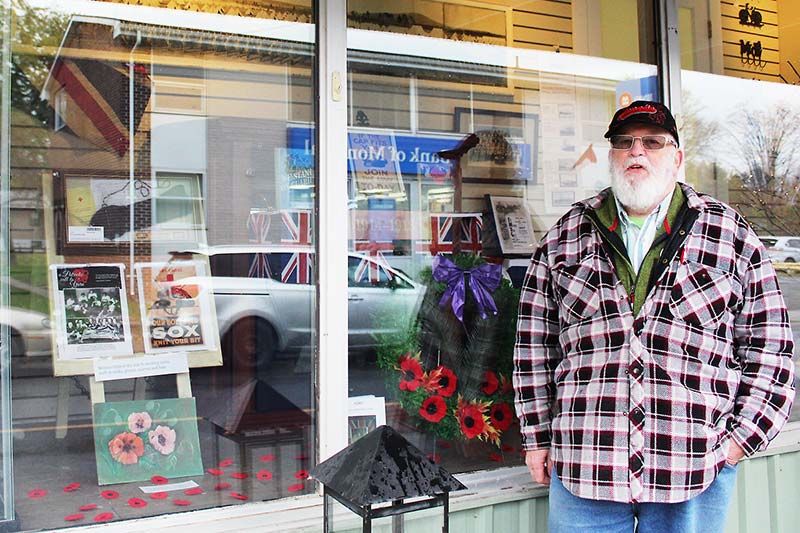Craig Bakay | Nov 07, 2018
Back when Verona had a Royal Canadian Legion Branch, new member Doug Lovegrove was a little concerned that there wasn’t much commemorating the First World War and in particular the 146th Overseas Battalion, which was a unit in the Canadian Expeditionary Force from Dec. 22, 1915 to July 17, 1917.
The 146th, you see, was formed from recruits in Frontenac, Lennox & Addington Counties.
So Lovegrove set about finding out everything he could about the unit (the results of his search are online at 146battlion.ca).
Being that this year is the 100th anniversary of the guns falling silent on Nov. 11, 1918, Lovegrove put together a special display in the storefront window of Nicole’s Gifts in Verona. Owner Nicole Van Camp’s daughter and son-in-law are officers in the Royal Canadian Air Force.
“This display is a conglomerate of my own collection and museum stuff,” Lovegrove said. “For example, the big picture of the unit (91 inches wide) is on permanent loan to our museum from the museum in Bath.
“When I went down to see them, they said they didn’t know if they had anything on the 146th, but they had a picture upstairs and this was it.”
On Sept. 27, 1916, the 146th, aboard Her Majesty’s Transport (HMT) Southland left Halifax for England along with HMT Corsican, HMT Tuscania, HMT Lapland, HMT Laconia and cruiser HMS Roxburgh as well as two patrol boats and a trawler or a mine sweeper.
They arrived in England on Oct. 6, 1916, with 26 officers and 581 other ranks.
But, as Lovegrove said, “Their sole purpose was to replenish the front lines,” and as such, the unit was disbanded on Oct. 8, 1916 with a last parade and the officers and men were absorbed into other units. Most were sent to fight in France.
Lovegrove said he has documented 487 members of the 146th and suspects there were about 900 who were a part of the unit since its beginnings Nov. 28, 1915.
“On Nov. 11 this year, the community electronic bulletin board (in Verona) will display the names of the men we know and their flags,” Lovegrove said.
But there’s another aspect of military contribution that Lovegrove’s display also features — the contributions women made.
“In the First World War alone, there were about 3,000 nurses that joined the military,” he said. “And then there were Red Cross and Salvation Army nurses, about 4,500 total.”
The official total was 4,518 nursing sisters, of whom 92 died.
There were also home nurses, many of whom served at the Sydenham Military Hospital during WWI. The hospital is now the site of the Isabel Bader Centre for the Performing Arts.
In the Second World War, there were 7,000 WRCNS in 39 trades, 20,545 CWACs in 55 trades, 17,038 WDs in 65 trades, 4,480 nursing sisters, 640 Red Cross personnel and 260 St. John’s Ambulance personnel. Seventy-three died and 19 were wounded.
There were 16 nursing sisters in the Korean War and 237 Canadian Forces personnel in the 1991 Gulf War. From 1986 to 2000, 2,573 women served in Canadian military peace keeping operations.
At the age of 72, Lovegrove said, “I was too young to have served in the wars as I was born just after the Second World War was over.”
But, he served in the military from 1967 to 1991 with NATO forces in Germany and with the United Nations in the Golan Heights and Cyprus.
And he wears the Poppy proudly.
“Since 1921, the Poppy has stood as a symbol of Remembrance, our visual pledge to never forget all those Canadian who have fallen in war and military operations,” he said. “The Canadians who died believed in a better future.
“We have inherited that future in a rich and beautiful country and it’s up to us to continue to work for that better future.
“If we do, we will have remembered and they will know that their their faith in the future wasn’t misplaced.”
Doug Lovegrove stands in front of the Remembrance display in the window of Nicole’s Gifts in Verona. “Nicky’s been very supportive,” he said. Photo/Craig Bakay
More Stories
- No Winner Yet in Catch The Ace But Fundraising Target Met
- South Frontenac Food Bank Opens Second Location in Battersea
- Sharbot Lake Pentecostal Church Anniversary - 1925-2025
- Frontenac Holistic Health Fair - September 20 At Storrington Centre
- Odd Year For Real Estate - But Sales Are Steady Year Over Year
- 193rd Kingston Fall Fair
- Kim Phuc - the Napalm Girl - To Visit Flinton In November
- South Frontenac Council - September 2
- Sticker Shock - EV Charging Station To Cost North Frontenac Township
- 30th Anniversary Verona Car Show

